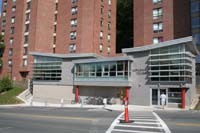MCLA receives architectural award for Berkshire Towers
 |
| Berkshire Towers Lobby |
Berkshire Towers, first built in 1973, began undergoing renovations in 2008. The brick towers now have a street-level entrance with an elevator to the main lobby. The old design had residents and guests enter on the second floor, using an exterior ramp.
Other additions to the space include a pull-off area for vehicles in front of the building, a kitchenette, new meeting and multi-purpose rooms, a new front desk, and a new laundry room and lounge space. “It’s an honor for the College to have a building project that’s been recognized by the state,” said Diane Manning, director of Residential Programs at MCLA. “It’s nice knowing that we have a facility welcoming to all... It’s really important to make sure buildings are accessible to all members of the MCLA community.
“The building was so lacking in any public space, and it’s so heart-warming to see the students in the meeting and multi-purpose rooms,” she added. “It’s such an improvement to the quality of life of the students in general.” The Berkshire Towers renovation project was designed by Kuhn Riddle Architects of Amherst.
The Massachusetts State College Building Authority funded the construction project through a $4 million bond. For more information on MCLA visit www.mcla.edu.















